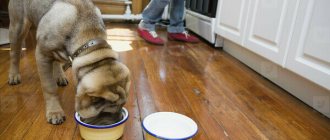Calcium gluconate is a fine white powder with low solubility in water.
The drug contains calcium, an active element that participates in the processes of excitation of the nervous system, improves the connective properties of cells, promotes the transmission of heart rhythms, muscle contractions, and blood clotting.
The main task of this substance in the body, in addition to activating enzymes and hormones, is to ensure plasticity, functionality and proper bone structure.
Is it possible to give?
The drug is given to dogs to treat diseases or to prevent calcium deficiency. The drug is used to stimulate and normalize the immune system, metabolism, is a hemostatic drug and has a wide range of applications.
Indications
Dogs should be treated in the following cases:
- postoperative hemorrhages and hemostatic arrest of various locations (pulmonary, intestinal hemorrhages);
- neuroses;
- stimulation of labor and separation of placenta;
- allergic reactions;
- rickets (abnormal bone growth due to a lack of lime salts in the body, metabolic disorders);
- tetany (painful involuntary muscle contraction);
- calcium metabolism disorders;
- bleeding disorders.
For epilepsy
In the case of epilepsy, calcium gluconate is taken in combination with other drugs and antiepileptic drugs as a substance that activates the transmission of nerve impulses. It promotes the contraction of smooth and skeletal muscles, so it can be used for epilepsy.
Instructions for use
Dosage in tablets
You should independently calculate the dosage of calcium gluconate tablets depending on the norms and goals pursued (prevention or treatment) with a known norm calculated by veterinarians - 320 mg per 1 kg of weight in puppies, 119 mg per 1 kg of weight in an adult dog.
Usually, taking tablets is divided into two - in the morning and in the evening together with food.
Injection
The injection form of the drug is available in the form of ampoules with a solution in a concentration of the substance of 5-10%, which acts more sparingly. In this form, the daily norm for dogs is 1-5 ml, depending on the breed.
Intramuscular, subcutaneous or intravenous?
Calcium gluconate is injected intravenously and intramuscularly. In rare cases - subcutaneously. This distribution is not without reason.
Subcutaneous injection may cause burns. The burn in turn causes an abscess and tissue necrosis. Subcutaneously (as well as intramuscularly) the drug is administered only with saline or 5% glucose solution in a ratio of 1:10-1:20, then it is more easily tolerated.
You should also check that there are no alcohol residues at the end of the needle, since ethyl alcohol residues cause sediment to form in the drug.
Where and how to inject?
Before giving the injection, you should carefully read the attached instructions and consult your veterinarian about what dosage is suitable for use in your case. An intramuscular injection is given into the muscle of the animal's hind leg.
Before the injection, you should warm the solution to room temperature, disinfect the injection site by pre-treating it with an alcohol-containing solution, then insert the needle. If the drug is prescribed intravenously, the injection is given into a vein, it is advisable to administer a drip.
Orally
In some cases, veterinarians may prescribe calcium gluconate by mouth. You should not use a solution for this; most owners crush the required dosage of the tablet and mix it with food, add it to meat or minced meat.
Since excess calcium is not excreted from the body and causes secondary mineral deficiency, it should be introduced into your pet's diet with caution.
For a puppy, the daily dose of the substance should not exceed 320 mg per 1 kg of weight; as the dog grows, the dose should be gradually reduced to 120 mg. On average, dogs are given 2-4 g or 1-5 ml of medication per day.
Top 5 Supplements
Here are some of the most popular feed additives with calcium.
Calcium chloride
The dosage is calculated based on the weight of the dogs, and the contraindication is a tendency to thrombosis.
Calcium gluconate
The drug is available in the form of tablets and ampoules for injection. It has the same indications, but acts in a more gentle way. The medicine can be crushed into food, administered intravenously and intramuscularly. The active substance is also present in a concentration of 10%. The daily dosage for dogs is 1-5 ml depending on the breed. Contraindication – individual intolerance.
Excel Calcium
The product is in the form of chewable tablets. It consists of 10% calcium, 7.5% phosphorus, 7% fats and oils, 235 IU of vitamin D. This percentage allows the supplement to be easily absorbed by the body. After taking the entire course (2 weeks), the condition of teeth, bones, and cartilage improves. A dog up to 10 kg is given 1 vitamin, up to 25 kg - 2 pieces, over 25 kg - 3 pieces per day. Contraindication – allergy to auxiliary components.
Unitabs Calcium Plus
The supplement is made in the form of 1.5 gram tablets. The main substances are Ca, P and vitamin D in an easily digestible form. The drug is added to the feed or given separately at the rate of 1 piece per 5 kg of weight. It is allowed to feed puppies from three weeks of age, elderly dogs and dogs weakened by illness. No contraindications or side effects were found.
Kanvit with calcium and gelatin
The feed additive contains Ca, P, Na + gelatin hydrolysate. It is prescribed to puppies, pregnant dogs, during lactation, dogs with large body weight, and elderly animals.
For prevention, it is enough to give 1 tablet per 5 kg of weight per day, during growth and pregnancy - 3 tablets, for treatment - 5 tablets. There are also no contraindications or side effects identified.
Older dogs should receive a little more calcium, but in a hypoallergenic, easily digestible form.
Dosages of medications for dogs, cats, ferrets, birds used in veterinary medicine.
Abbreviations: intravenous - intravenous; s/c - subcutaneously; IM - intramuscular; p/o - orally; g/kg - grams per kilogram of animal weight; mg/kg - the number of milligrams of active substance per 1 kilogram of animal weight; µg/kg - micrograms per kilogram of animal weight; ml/kg - milliliters per kilogram of animal weight. (!) - important information
We recommend reading: How to inject oxytocin during childbirth in a dog
Dogs, cats : 0.5 mg/kg at intervals of 12 hours po after meals.
Orally 12.5-25 mg/kg with an interval of 8-12 hours.
Rabbits : 50-100 mg/kg at 12-hour intervals.
Ferrets : 0.2-0.5 mg/kg IM, SC, PO.
Rabbits : 0.1-1 mg/kg IM, s.c.
1. Transmissible venereal sarcoma - 0.025 mg/kg IV with an interval of 7 days for 4 weeks.
Cats : 1. B1 deficiency - 10-25 mg per cat IM, SC, PO with an interval of 12-24 hours. 2. For lead poisoning - 2 mg/kg IM, SC with an interval of 12 hours. 3. Ethylene glycol poisoning - 100 mg per cat IM, SC, PO with an interval of 24 hours.
Cats : 2-4 mg/kg with an interval of 6-8 hours p/o, sc, i/m.
Cats : 0.2-0.3 mg/kg subcutaneously every 2 weeks for 6-8 weeks (notoedrosis, otodectosis).
Small mammals : 0.2-0.5 mg/kg s.c., po with an interval of 7-14 days.
Ferrets (dermatophytosis): 15 mg/kg or 25-33 mg per ferret po at 24-hour intervals.
Guinea pigs : 5 mg/kg po every 24 hours.
Cats : parenteral 95-140 mg calcium gluconate/kg slowly IV (using 10% gluconate or borgluconate solution equivalent to 1-1.5 ml/kg). Oral: 10-20 mg calcium per kg po every 6-8 hours.
Cats : 2 mg/kg SC at 24-hour intervals for up to 3 days; 1 mg/kg po with an interval of 24 hours up to 5 days.
Ferrets : 1 mg/kg SC, IM, PO every 24 hours.
Cats : 0.5-5 ml po with an interval of 8-12 hours.
Cats : starting dose - 0.1 mg/kg, then 0.05 mg/kg po with an interval of 24 hours. Prevention of pain before surgery - 0.2 mg/kg (effective for 24 hours), then 0.05 mg/kg orally at intervals of 24 hours is effective. It can be used as a single dose of 0.3 mg/kg s.c. to control postoperative pain.
Rabbits : 0.3-0.6 mg/kg s.c., po with an interval of 24 hours.
Cats : 1.88 mg/cat po with an interval of 48 hours (if necessary, either the dose or the frequency of application can be doubled to 24 hours).
Alternatively : Dogs : 1/4 of a 15 mg tablet for 30kg dogs.
Rabbits : 0.3-0.6 mg/kg s.c., po with an interval of 24 hours.
Important building materials of the body are calcium and phosphorus. Thanks to them, teeth and bones gain strength, become healthy and strong. All dogs need such a trace element as calcium - regardless of breed, in young and mature pets. In puppies, the skeleton develops correctly during the period of intensive growth, in older dogs, bones are strengthened and pain is eliminated.
Caring owners understand how important it is to add calcium supplements to their pets' diets. Few people know that vitamins with calcium for dogs are not the same as those sold for people, and if you need to buy calcium for your dog, you should do this in specialized stores and only those supplements that are made specifically for pets.
Pregnant
Calcium gluconate is perfect for taking during childbirth and after childbirth.
During childbirth
If the natural birth of a dog has complications, the body of the giving birth dog should be supported with calcium gluconate, since the ions of the substance have a beneficial effect on the activity of the smooth muscles of the uterus, the drug promotes its contraction and the successful separation of the placenta and remaining unnecessary pieces of the birth mucosa.
But you should carefully follow the instructions, otherwise there is a chance of harming the dog.
After them
You should also support the animal’s body after birth, especially if there is a suspicion of eclampsia. In this case, the dog is injected intravenously with a solution of glucose 5% and calcium gluconate 10% (dosage - 0.5-1.5 ml per 1 kg of animal weight) or 0.5 ml of a solution of calcium gluconate immediately after birth intravenously very slowly.
If it is not possible to administer the solution intravenously to the dog, it should be given orally or administered subcutaneously with saline in a ratio of 1 to 1. It is possible to use the drug for preventive purposes before childbirth in the form of supplements containing this microelement.
Nutrition standards
Regardless of the type of food (natural or dry), the dog must eat strictly according to the regime. The frequency of food intake in puppies is determined by their age and corresponds to the following indicators:
- Babies up to two months are fed 6 times a day;
- at the age of 2−4 months - five times;
- 4−6 months - four times;
- 6−12 months - three times.
In the future, the pet is fed in the morning and evening. The amount of food for a single meal should be small, however, the food should be easily digestible and nutritious. The more food an animal eats, the worse it is digested, and the pet often develops diarrhea.
It is necessary to observe the quantitative ratio of phosphorus and Ca in consumed products. The best option is a proportion of 1:1−2 (1 part phosphorus and 1−2 parts calcium). To effectively absorb these elements and maintain proper levels of their content in the blood, it is necessary to give puppies additional vitamin D. However, owners should be very careful, since this vitamin is the most toxic of all fat-soluble vitamins, so the recommended dosage should be strictly adhered to. For puppies, the dose of the drug is 20 units/1 kg of weight, for adults - about 10 units.
We recommend reading: Your Dog Has a Big Belly How to Treat it
For puppies
Puppies are also given calcium gluconate, because it is the main building material for bone tissue. The daily intake of the substance for puppies during the period of intensive bone tissue formation should be 529 mg per 1 kg of body weight.
You can use the drug in tablets together with calcium glycerophosphate in a 1:1 ratio. In this case, it is worth considering that every month of the puppy’s life the dose should be increased by 2 tablets.
For example, a one-month-old puppy receives 2 tablets of calcium gluconate and 2 tablets of calcium glycerophosphate per day, then a two-month-old puppy should receive 4 to 4, a three-month-old - 6 to 6, and so on until he reaches six months of age.
Newborn puppies should not be given the drug unless absolutely necessary, because they receive all the beneficial substances from their mother’s milk.
Calcium for puppies and dogs on natural food
Probiotics for dogs for digestion of small, medium and large breeds
If the puppy is naturally fed, then it is quite difficult to track the amount of calcium entering the body. For example, if an animal eats only meat, then in order for the body to receive the required daily dose of this element, it needs to eat 30 kg of meat per day.
A lot of calcium is contained in vegetables and fruits, but giving them to a puppy as the main diet will not work, so if the animal is naturally fed, it is additionally prescribed vitamins or special complexes for dogs, which contain the necessary portion of calcium and other important elements.
Healthy foods
To ensure that puppies and adult dogs receive the required amount of calcium, it is recommended to add bone meal or crushed egg powder to the diet.
Calcium content in food
Important! Calcium absorption occurs only together with phosphorus and vitamin D, so it is necessary to ensure that these substances enter the body daily.
It is important to give calcined cottage cheese to puppies and dogs under three years of age, but adult dogs should not be given dairy products, because their bodies cannot digest such food. There is also a lot of calcium in peas, beans, oatmeal and nuts.
How much calcium is in natural food?
With natural feeding, the animal does not receive the necessary portion of calcium, so additional vitamins prescribed by the veterinarian must be given.
The greatest amount of calcium is found in processed cheese, cottage cheese, feta cheese, almonds, mustard, and pistachios. It is present in slightly smaller quantities in oatmeal, barley, peas, walnuts, cream, sour cream and beans.
Reviews
Very often, dog owners are faced with a lack of understanding in which cases to use calcium gluconate, in what doses, how correctly and where to give the injection.
In such situations, you should carefully read the instructions for use and follow the veterinarian’s recommendations. After all, incorrect doses and forms of use can lead to an excess of the substance in the body, causing abscesses, necrosis and other unpleasant consequences, which can, unfortunately, lead to death.
Causes of calcium deficiency in a dog's body
Carrier for dogs of small, medium and large breeds
There may be several reasons why there may be a lack of this element in the body. Each of them has negative consequences for the animal, but the presence of several at once in most cases leads to death:
- unbalanced diet, which lacks all the necessary vitamins and elements. The risk group most often includes puppies or young animals. For example, if an animal’s food consists exclusively of food of plant origin, then it cannot fully saturate the pet’s body with all useful components, including calcium and phosphorus. During such a diet, a lack of mineral occurs, which is especially noticeable in large breed dogs;
- A disease such as tetany occurs most often in bitches during the birth and postpartum period, as well as during lactation. At this time, the animal experiences an acute lack of calcium in the body, because all its reserves were used up during pregnancy. Small breed dogs are most susceptible to the disease;
- the presence of an endocrine disease, as a result, the synthesis of the hormone, due to which calcium absorption occurs, decreases.
The main symptoms of element deficiency include:
- apathetic state;
- fragility and fragility of bones;
- poor appetite;
- increased body temperature and shortness of breath;
- tachycardia;
- diarrhea, vomiting;
- increased aggressiveness.
Calcium is especially important for large breed dogs as they suffer from joint pain











